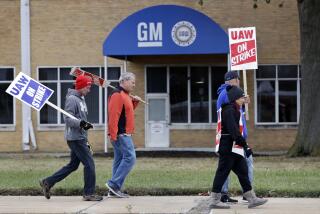GM-Chrysler Project Sets Precedents : Autos: The idea to make transmissions together, the first joint venture between two U.S. car makers, came from the ranks, not the top.
- Share via
DETROIT — It’s the kind of success story that one rarely hears from Detroit’s bureaucratic auto makers: A radical idea starts somewhere deep inside the organization, weaves its way up to the chairman’s office and then is actually adopted by the board and becomes precedent-shattering policy.
But that’s just what happened in the case of the new transmission-making joint venture between Chrysler and General Motors, the first joint project formed between two American auto companies.
GM and Chrysler executives, who first announced a tentative agreement in October to form the joint venture, called New Venture Gear, have just closed the deal. They held their first press conference here Tuesday to discuss the project in detail.
They disclosed that the concept of spinning off one GM transmission factory in Indiana and a Chrysler facility in upstate New York to form a joint venture grew out of discussions among mid-level managers in the two firms’ parts-making operations.
At the time, top GM and Chrysler executives were not even thinking about cooperating with their cross-town rivals; both firms already had joint ventures with Japanese auto makers. And, historically, Washington had frowned on mergers in Detroit.
But the GM and Chrysler managers took it to their respective bosses--who were surprised and excited by the idea. Plenty of lawyers were brought in; but in the end, the plan survived the scrutiny of both firms’ boards and later easily obtained approval from the Bush Administration.
“The (GM) board was as intrigued as we were, as intrigued as you guys in the press are,” said William Hoglund, GM’s executive vice president in charge of the company’s parts-making operations.
At Chrysler, company Chairman Lee A. Iacocca “was very excited about it. He really liked the idea,” said David Zimmer, a Chrysler executive just named to be the first president of New Venture Gear.
For some inside GM and Chrysler, the fact that the idea was able to fly offers hope that Detroit’s traditional top-down management style may finally be breaking down, that it may be possible for ideas to flow more freely through the bureaucracy.
“What was exciting about this was that it was operating guys who put this together, rather than the financial staff” at corporate headquarters, Zimmer said. “I think this is interesting because it came up through companies that were traditionally very hierarchical.”
The joint venture idea met with such a warm response because the two firms found they had a natural fit in the transmission business.
The production line at GM’s Muncie, Ind., transmission plant has been running at just 40% of capacity because of GM’s sales slump and was in danger of being closed. Meanwhile, Chrysler’s Syracuse, N.Y., plant, which produces transmissions and related components for four-wheel-drive vehicles for Chrysler and other auto makers, could scarcely keep up with the industrywide demand for four-wheel-drive utility vehicles.
Under the joint venture, which is expected to have annual sales of about $650 million, Chrysler will be able to use Muncie to produce parts that are now in short supply from Syracuse, while GM will thus be able to make better use of a plant that hasn’t had enough work.





